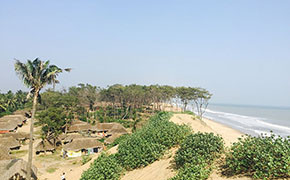Environmental migrations: a certainty in the future?
It is frequently claimed that more and more migrations will result from environmental changes caused by global warming.
The understanding is that sea rise, together with rising numbers of increasingly devastating natural disasters, will force growing numbers of people to flee their homes, and the conclusion is that a near-mechanical connection holds between climate change and migrations.
Greater vulnerability
Demographic growth and higher human density due to coastal area urbanization have greatly increased the number of people exposed to sea rise. A considerable proportion of the world’s largest conurbations are located on seacoasts, exposing large populations to flood risk, as we saw in New York with Hurricane Sandy. If the number of natural disasters increases as expected, the number of people in vulnerable situations will continue to grow.
However, people who have been hit by extreme events may move without really migrating. During floods, people often seek shelter in neighboring regions but return to their homes as soon it seems to them feasible to do so. When a cyclone is announced in the Bay of Bengal, inhabitants take refuge in facilities built for that purpose, returning to their own dwellings as soon as the danger is over. Over 500,000 people in the Indian state of Odisha left their homes when Cyclone Phailin was announced in 2013, but these were not migrations strictly speaking, which always involve lasting moves some distance away. On the other hand, a prolonged drought such as the one in the Horn of Africa can have quite a different impact on population movement: environmental changes such as this may be less devastating but can induce real migration that is very likely to definitive.
Resistance to migration?
Violent climatic events are extremely varied, and affected populations may be reluctant to migrate. Floods and hurricanes constitute immediate physical dangers, causing inhabitants to flee, but only temporarily. In Bangladesh, some inhabitants of the Brahmaputra delta escaped the rising waters by going to Dacca or migrating within India, but others simply moved nearby and settled on newly emerged land. Years of drought can drastically worsen living conditions, particularly in farming areas, without provoking mass departures. Farmers may well try to adapt by switching from crops to livestock.
We do observe a type of resistance to migrating: inhabitants of zones exposed to climate change-related risks are tempted to reduce those risks by building more appropriate housing and other structures; e.g., cement houses on raised embankments that might stand up to cyclones and flooding, higher dams for better protection against tsunamis, or buffer zones to collect runoff from violent storms and so prevent damage to settled areas.
Moreover, a family facing an extreme natural event may be spared migration thanks to assistance from a member who has already migrated for economic rather than environmental reasons. Earlier, economic migration may prevent or at least delay migration.
Moving is not migrating. The number of temporary population movements may skyrocket in number without migrations doing likewise. This in no way diminishes the challenge posed to many populations by climate change. But the future does not seem entirely predictable.
Contact: Jacques Véron
Online: December 2016

